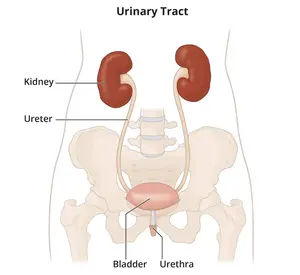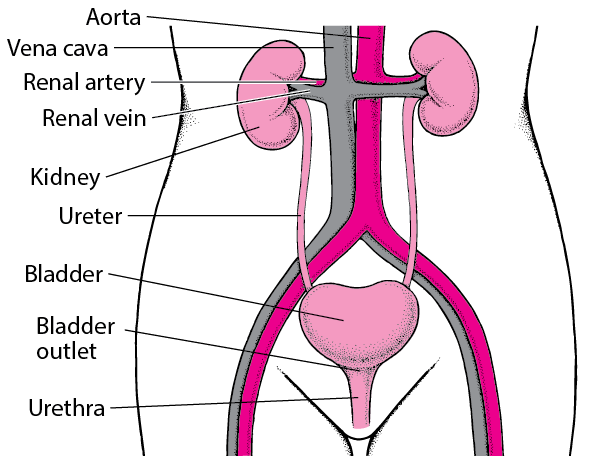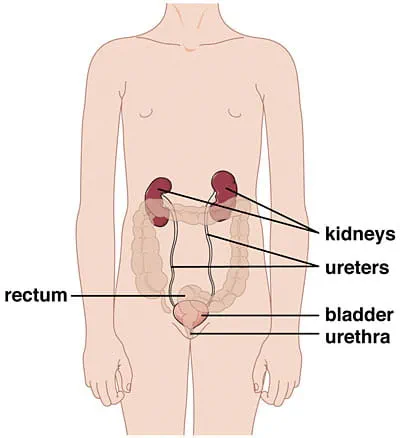Pinnacle of Wellness: A Holistic Approach to Urinary Tract Health
This comprehensive guide explores the intricate details of the urinary tract, a vital system responsible for waste elimination, fluid and electrolyte balance, blood pressure regulation, and more. The urinary tract comprises the kidneys, ureters, bladder, and urethra, each playing a unique role. The process of urination involves filtration in the kidneys, transport through the ureters, storage in the bladder, and release through the urethra. Common urinary tract issues include infections, kidney stones, and incontinence. To maintain a healthy urinary tract, staying hydrated, practicing good hygiene, adopting a balanced diet, exercising regularly, and seeking medical attention for symptoms are crucial. The urinary tract's importance lies in its role in waste elimination, fluid balance, blood pressure regulation, toxin removal, and supporting the immune system. Regular check-ups and healthy lifestyle choices contribute to overall urinary tract health.
Maintaining Urinary Tract Health: Key Practices for Well-being

The urinary tract is a system of organs within the human body responsible for the production, storage, and elimination of urine. It plays a vital role in maintaining the body's internal balance by regulating the concentration of electrolytes and fluids. The primary components of the urinary tract include the kidneys, ureters, bladder, and urethra.
Anatomy of the Urinary Tract
The urinary tract consists of four main parts: kidneys, ureters, bladder, and urethra.
Kidneys:
- Located on either side of the spine, the kidneys filter blood to remove waste products and excess fluids, producing urine.
- Two bean-shaped organs located on either side of the spine.
- Renal arteries bring blood to the kidneys, where it undergoes filtration, and the purified blood returns to circulation via renal veins.
Ureters:
- These are muscular tubes that transport urine from the kidneys to the bladder.
- Peristaltic contractions of the ureter walls help move urine downward, preventing backflow.
Bladder:
- The bladder is a muscular organ that stores urine until it is ready to be expelled.
- Detrusor muscles in the bladder wall contract to push urine into the urethra during urination.
Urethra:
- The urethra is a tube that carries urine from the bladder to the outside of the body.
- In males, the urethra also serves as the passage for semen during ejaculation.

Why is the urinary tract important?
The urinary tract is a critical system in the human body with several important functions, making it vital for overall health and homeostasis. Here are some key reasons why the urinary tract is important:
1. Waste Elimination:
- The primary function of the urinary tract is to eliminate waste products from the body. The kidneys filter blood, removing excess fluids, electrolytes, and waste materials to form urine.
2. Fluid and Electrolyte Balance:
- The urinary tract plays a crucial role in regulating the balance of fluids and electrolytes (such as sodium, potassium, and chloride) in the body. Maintaining this balance is essential for proper cellular function and overall health.
3. Blood Pressure Regulation:
- The kidneys help regulate blood pressure by adjusting the volume of blood and the concentration of electrolytes. They release the enzyme renin, which plays a role in blood pressure control.
4. Acid-Base Balance:
- The urinary system helps maintain the body's acid-base balance by excreting hydrogen ions and reabsorbing bicarbonate ions, contributing to the regulation of blood pH.
5. Erythropoiesis Regulation:
- The kidneys produce and release erythropoietin, a hormone that stimulates the production of red blood cells in the bone marrow. This helps ensure an adequate oxygen-carrying capacity in the blood.
6. Toxin Removal:
- In addition to waste products, the urinary system helps eliminate various toxins and drugs from the body, contributing to detoxification processes.
7. Immune System Support:
- The urinary tract has mechanisms to prevent and combat infections. The flow of urine can flush out bacteria, and the acidic nature of urine inhibits the growth of certain microorganisms.
8. Maintenance of Osmotic Pressure:
- The kidneys regulate osmotic pressure by adjusting the concentration of solutes in the urine. This helps prevent excessive water loss or retention, maintaining the body's water balance.
9. Storage and Controlled Release of Urine:
- The bladder serves as a reservoir for storing urine until the body is ready to eliminate it. Controlled release of urine through the urethra allows for voluntary and coordinated urination.
10. Detection of Abnormalities:
- Changes in urine color, composition, or the presence of certain substances can serve as indicators of underlying health issues. Urinalysis is a diagnostic tool used to detect abnormalities in the urinary system and other parts of the body.
Given these essential functions, any disruption or dysfunction in the urinary tract can lead to various health problems, including kidney disease, urinary tract infections, and electrolyte imbalances. Maintaining the health of the urinary tract is crucial for overall well-being and requires adopting a healthy lifestyle, staying hydrated, and seeking medical attention for any concerning symptoms or conditions.

How does urination occur?
Urination, also known as micturition, is a complex process that involves the coordination of various muscles and structures within the urinary tract. The process can be divided into several stages:
1. Filtration in the Kidneys:
- The process of urination begins in the kidneys, where blood is filtered to remove waste products, excess salts, and fluids.
- The filtered material, known as urine, is then directed to the renal pelvis, a funnel-shaped structure that collects urine from the kidney's nephrons.
2. Transport through the Ureters:
- The urine flows from the renal pelvis into the ureters, muscular tubes that connect the kidneys to the bladder.
- Peristaltic contractions of the ureter walls help move urine downward toward the bladder.
- The ureters prevent backflow of urine by means of one-way valves.
3. Storage in the Bladder:
- The bladder, a muscular organ, serves as a reservoir for storing urine until the body is ready to expel it.
- The detrusor muscles in the bladder wall relax to allow the bladder to expand and fill with urine.
4. Initiation of Urination:
- The initiation of the urination process is a voluntary action, controlled by the central nervous system.
- When the bladder is sufficiently full, stretch receptors in the bladder wall send signals to the spinal cord, which, in turn, send signals to the brain indicating the need to urinate.
5. Contraction of the Bladder:
- Upon receiving signals from the brain, the detrusor muscles in the bladder contract.
- The internal sphincter, a muscular ring at the bladder's outlet, relaxes to allow urine to flow into the urethra.
6. Release through the Urethra:
- The urethra, a tube that carries urine from the bladder to the exterior of the body, acts as a passageway for urine elimination.
- The external sphincter, a voluntary muscle surrounding the urethra, relaxes under conscious control, allowing urine to be expelled from the body.
7. Completion of Urination:
- Once the bladder is emptied, the detrusor muscles relax, and the sphincters contract, preventing further urine release until the bladder fills again.
The entire process is regulated by a complex interplay of nervous system signals and muscle contractions. Disruptions in this coordination can lead to issues such as incontinence or difficulty emptying the bladder. Additionally, the sensation of needing to urinate is a crucial aspect of the process, signaling when it is appropriate to initiate the act of urination.
Common Urinary Tract Issues
1. Urinary Tract Infections (UTIs):
- UTIs occur when bacteria enter the urinary tract, leading to symptoms like pain, burning during urination, and increased frequency.
2. Kidney Stones:
- Formed from crystals in the urine, kidney stones can cause severe pain when passing through the urinary tract.
3. Incontinence:
- Inability to control urine flow, often associated with weakened pelvic floor muscles or nerve damage.
4. Enlarged Prostate (in males):
- A common issue in older men, an enlarged prostate can obstruct the urethra, causing difficulty in urination.
Preventive Measures
1. Stay Hydrated:
- Drinking an adequate amount of water helps flush out toxins and bacteria from the urinary tract. Aim for at least 8 glasses (64 ounces) of water per day, or more if you are physically active or in a hot climate.
2. Practice Good Hygiene:
- Keep the genital area clean to prevent the introduction of bacteria into the urethra. Wipe from front to back after using the toilet to avoid transferring bacteria from the anal region to the urethra.
3. Urinate Regularly:
- Don't hold in urine for extended periods. Emptying your bladder regularly helps prevent the growth of bacteria and reduces the risk of urinary tract infections.
4. Cranberry Products:
- Some studies suggest that cranberry products may help prevent urinary tract infections by preventing bacteria from sticking to the urinary tract walls. Consider incorporating unsweetened cranberry juice or supplements into your diet.
5. Maintain a Healthy Diet:
- Eat a balanced diet rich in fruits, vegetables, whole grains, and lean proteins. This helps support overall health and can contribute to a healthy urinary tract.
6. Limit Caffeine and Alcohol:
- Excessive consumption of caffeine and alcohol can irritate the bladder. Limiting these substances may help prevent irritation and reduce the risk of bladder issues.
7. Regular Exercise:
- Physical activity promotes healthy blood flow and can contribute to the overall well-being of the urinary tract. Kegel exercises, which strengthen the pelvic floor muscles, are particularly beneficial.
8. Maintain a Healthy Weight:
- Being overweight can contribute to urinary tract issues. Maintaining a healthy weight through diet and exercise can reduce the risk of conditions such as urinary incontinence.
9. Practice Safe Sex:
- Use barrier methods, such as condoms, to prevent sexually transmitted infections (STIs) that can affect the urinary tract.
10. Manage Chronic Conditions:
- If you have diabetes or other chronic conditions, work with your healthcare provider to manage them effectively. Chronic conditions can impact urinary tract health.
11. Avoid Smoking:
- Smoking can contribute to bladder and kidney problems. If you smoke, consider quitting to improve overall urinary tract health.
12. Regular Check-ups:
- Schedule regular check-ups with your healthcare provider. They can monitor your urinary tract health, address any concerns, and provide guidance on preventive measures.

Frequently asked Questions (FAQ)
- How do I clear my urinary tract?
- What are the causes of a urinary tract infection?
- What is the definition of the urinary tract?
- Can sperm cause UTI in females?
- Do urinary tract infections go away?
- Can condoms cause UTI?
- What are 3 symptoms of a UTI?
- What are the 5 warning signs of bladder infection?
How do I clear my urinary tract?
- Drinking plenty of water to flush out bacteria.
- Taking over-the-counter pain relievers.
- Using a heating pad to alleviate discomfort.
- Avoiding irritants like caffeine and alcohol.
- Taking prescribed antibiotics if the infection is bacterial.
What are the causes of a urinary tract infection?
- Bacteria, most commonly Escherichia coli (E. coli), entering the urethra and traveling to the bladder or kidneys.
- Sexual activity, especially in women.
- Use of certain types of contraceptives.
- Menopause-related hormonal changes.
- Urinary tract abnormalities.
- Catheter use.
- Diabetes and other medical conditions affecting the immune system.
What is the definition of the urinary tract?
- The urinary tract is a system of organs, including the kidneys, ureters, bladder, and urethra, responsible for the production, storage, and elimination of urine.
Can sperm cause UTI in females?
- While rare, introduction of bacteria into the urethra during sexual activity can contribute to UTIs. However, it's not the sperm itself but rather bacteria that may be introduced from the genital area.
Do urinary tract infections go away?
- UTIs typically require treatment with antibiotics to clear the infection. If left untreated, UTIs can worsen and may lead to more severe complications, such as kidney infections.
Can condoms cause UTI?
- Condom use is generally not a direct cause of UTIs. However, certain types of condoms or spermicides may contribute to irritation in some individuals, increasing the risk of UTIs.
What are 3 symptoms of a UTI?
- Pain or a burning sensation during urination.
- Frequent urge to urinate.
- Cloudy or strong-smelling urine.
What are the 5 warning signs of bladder infection?
- Lower abdominal pain or discomfort.
- Pain or discomfort during sexual intercourse.
- Urgency to urinate, even with small amounts of urine.
- Blood in the urine.
- Pelvic pain, especially in women.
Understanding the urinary tract's anatomy, functions, and common issues is crucial for maintaining overall health and well-being. By adopting preventive measures and seeking timely medical attention when needed, individuals can support the optimal functioning of their urinary tract and enjoy a healthier life.



